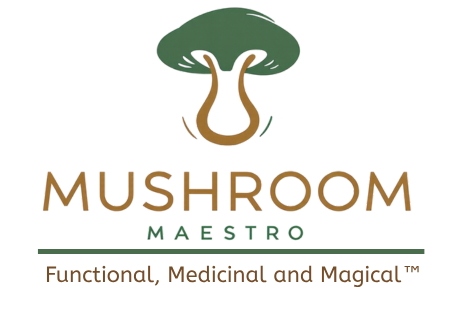In the ever-expanding world of holistic health and natural wellness, few remedies have garnered as much reverence and research as reishi mushrooms. Known for their profound adaptogenic properties, reishi mushrooms are frequently turned to for stress and anxiety support. Yet, a common source of confusion remains: red reishi vs reishi. Are they truly different, or are these terms simply used interchangeably to describe the same fungus? This distinction is far more than semantic; understanding the difference between red reishi and other forms of reishi can significantly impact how one approaches natural stress relief and anxiety management.
Red reishi, scientifically referred to as Ganoderma lucidum, is perhaps the most well-known and thoroughly researched among the reishi family. However, reishi mushrooms as a category encompass several varieties, each varying in color, composition, and medicinal efficacy. These distinctions are not merely superficial; they carry important implications for users seeking targeted health benefits. This article delves deep into the essential differences between red reishi and other reishi forms, explaining how each impacts stress and anxiety relief, the significance of reishi color, and what consumers need to know before selecting a supplement.
You may also like: The Essential Guide to Reishi Mushroom Benefits: How to Use Reishi Mushroom Powder for Stress Relief and Adaptogenic Support

Understanding Reishi Mushrooms: An Adaptogenic Powerhouse
Reishi mushrooms belong to a class of fungi known as polypores, found growing primarily on hardwood trees. Revered in traditional Chinese medicine (TCM) for over two millennia, they are often referred to as the “Mushrooms of Immortality” for their reputed longevity-enhancing properties. Modern science has begun to validate many of these ancient claims, revealing that reishi mushrooms possess potent immunomodulatory, anti-inflammatory, and adaptogenic effects.
Adaptogens are substances that help the body adapt to stress, restore balance, and protect against a variety of stressors, both physical and psychological. Reishi mushrooms fulfill this role exceptionally well. Through their complex blend of polysaccharides, triterpenoids, and peptidoglycans, they exert a stabilizing influence on the central nervous system. The result is often a measurable reduction in feelings of anxiety, improved sleep quality, and a greater sense of emotional equilibrium.
Red reishi, in particular, has been the subject of most clinical research. Its biochemical profile is especially rich in triterpenes, compounds known for their calming, anti-anxiety effects. This makes red reishi the top choice for individuals specifically targeting emotional and neurological stress. However, other reishi variants also contain beneficial compounds, albeit in varying proportions, which leads us to the critical distinction explored in this article.
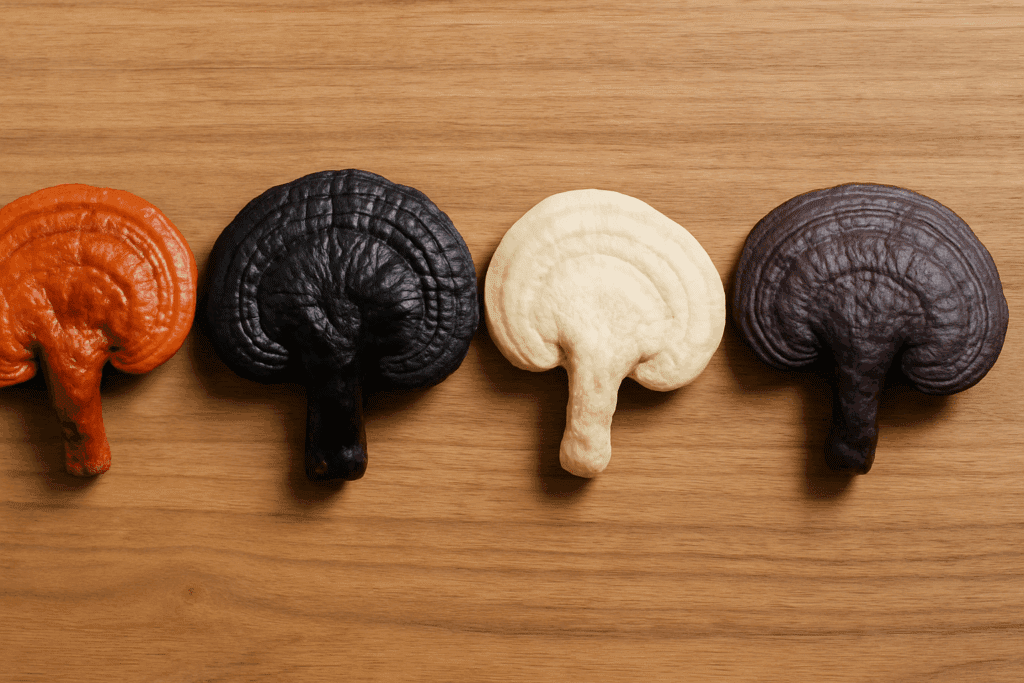
Decoding the Differences: Red Reishi vs Reishi
When comparing red reishi vs reishi in general, it becomes clear that the distinction lies in specificity versus generalization. The term “reishi” is often used as a catch-all phrase, referring to any member of the Ganoderma genus. This includes red reishi (Ganoderma lucidum), black reishi (Ganoderma sinense), purple reishi, and even rarer colors such as white and blue. Among these, red reishi is by far the most studied, cultivated, and consumed.
The color of a reishi mushroom is more than a cosmetic feature; it reflects variations in the mushroom’s genetic makeup, biochemical composition, and medicinal potency. Red reishi, with its glossy crimson cap, is considered the gold standard due to its high triterpenoid content and consistent therapeutic profile. It is typically cultivated on hardwood logs under controlled conditions, which ensures quality and uniformity.
In contrast, when a product is labeled simply as “reishi,” it could refer to any form of the mushroom, or even a blend of several types. This lack of specificity may dilute the targeted effects a user is hoping to achieve, especially if the goal is to alleviate stress or anxiety. Therefore, consumers seeking the highest level of stress-relieving properties would be wise to choose products explicitly labeled as red reishi.
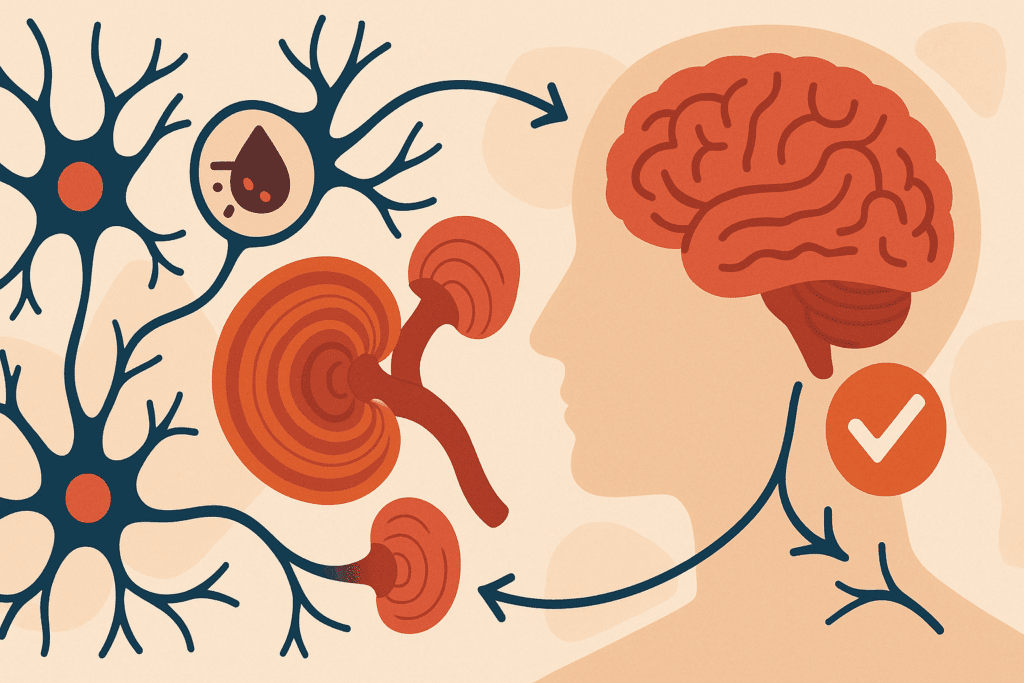
Biochemical Profiles and Their Impacts on Stress Relief
The bioactive compounds present in reishi mushrooms vary depending on the strain, growing conditions, and processing method. Red reishi stands out because it contains higher concentrations of ganoderic acids and lucidenic acids, both of which are subcategories of triterpenes. These compounds have demonstrated anxiolytic effects in both animal and human studies.
Triterpenes exert their calming effects by modulating the hypothalamic-pituitary-adrenal (HPA) axis, which governs the body’s stress response. Chronic activation of the HPA axis leads to elevated cortisol levels, often linked to anxiety, fatigue, and sleep disturbances. By regulating this pathway, red reishi helps buffer the impact of daily stressors and promotes a return to homeostasis.
Polysaccharides, particularly beta-glucans, are another cornerstone of reishi’s adaptogenic profile. While they are more commonly associated with immune support, beta-glucans also contribute indirectly to stress management by reducing systemic inflammation and improving gut health. The gut-brain axis is a well-established conduit for emotional regulation, and enhancing gut function can help mitigate anxiety symptoms.
Comparatively, other reishi colors contain lower levels of these compounds or possess different types of bioactives altogether. While they may offer other health benefits, such as cardiovascular support or antioxidant activity, they are not as directly effective for managing psychological stress. Thus, the discussion of red reishi vs reishi becomes crucial for individuals prioritizing mental well-being.
Red Reishi vs Reishi: Color and Clinical Potency
The discussion of reishi color is more than aesthetic; it reveals important clues about a mushroom’s chemical composition. Red reishi is unique in its ability to maintain high triterpenoid concentrations across various cultivation environments. Its consistency in chemical structure makes it a reliable choice for supplement manufacturers and researchers alike.
Black reishi, another commonly used variety, differs significantly. It contains lower triterpenoid levels but higher melanin content, which may support skin health and detoxification pathways. However, it lacks the same calming and mood-stabilizing effects that red reishi delivers so consistently. White reishi, although rare, has shown promise in early research for its anti-tumor properties, but again, lacks substantial evidence in the realm of stress and anxiety relief.
The color differences can also impact flavor and bioavailability. Red reishi is notoriously bitter due to its dense concentration of triterpenes, which ironically signals its therapeutic strength. Many users take red reishi in capsule or tincture form to avoid the harsh taste, although teas and decoctions remain popular in traditional medicine.
When examining red reishi vs reishi from a clinical perspective, the former emerges as the clear leader in stress relief efficacy. Not only is it supported by a more robust body of research, but its phytochemical composition is also better aligned with neurological health and emotional resilience. Therefore, color is not merely a visual trait—it is a predictive marker for therapeutic action.
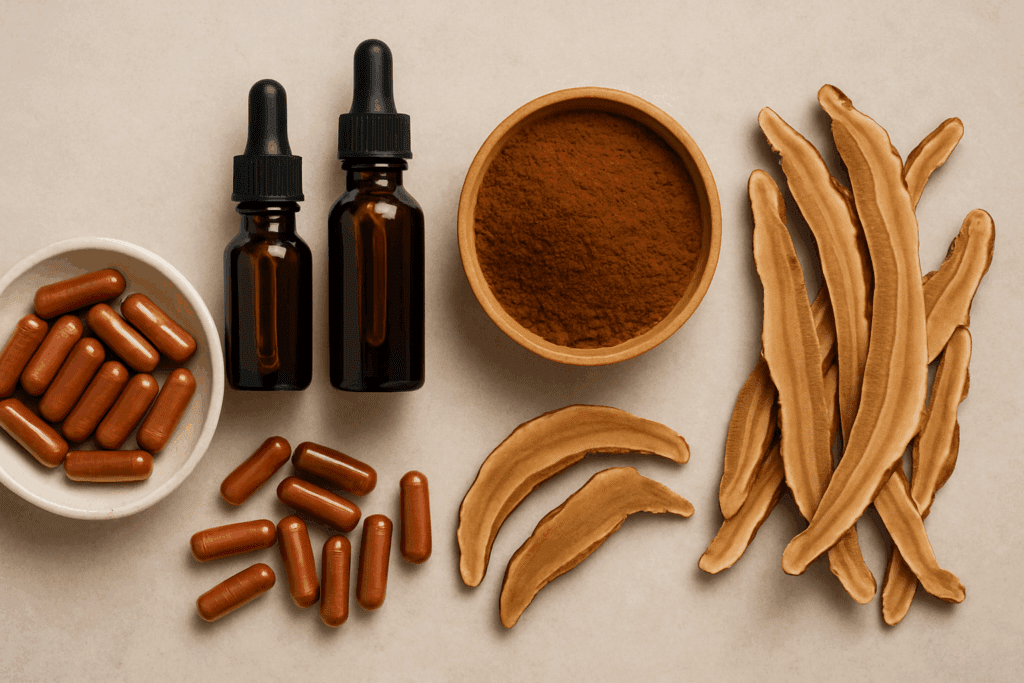
Dosage, Delivery, and Therapeutic Consistency
One of the challenges in harnessing the benefits of reishi mushrooms lies in standardizing dosage and delivery. The efficacy of any reishi supplement depends heavily on the form in which it is consumed, the extraction method used, and the consistency of active compounds. Here again, red reishi has a distinct advantage.
Because red reishi is the most widely cultivated and studied, manufacturers have developed more advanced extraction techniques tailored specifically to its bioactive profile. Dual extraction methods, which involve both water and alcohol, are commonly used to draw out polysaccharides and triterpenes respectively. This ensures a full-spectrum extract that delivers the mushroom’s complete range of benefits.
When products are generically labeled as “reishi,” there is often less transparency about which strain is used, how it was processed, or what dosage is effective. This ambiguity can lead to inconsistent results, particularly for individuals seeking relief from anxiety or chronic stress. In contrast, red reishi supplements tend to come with more detailed labeling and standardized dosages, making them a safer and more reliable option.
Additionally, the dosage required for therapeutic benefits varies based on individual needs and the form of the supplement. Clinical studies have found that daily doses ranging from 1.5 grams to 5 grams of red reishi extract are effective in reducing anxiety and promoting better sleep. For best results, consistency is key; adaptogens typically require several weeks of regular use to reach peak efficacy.
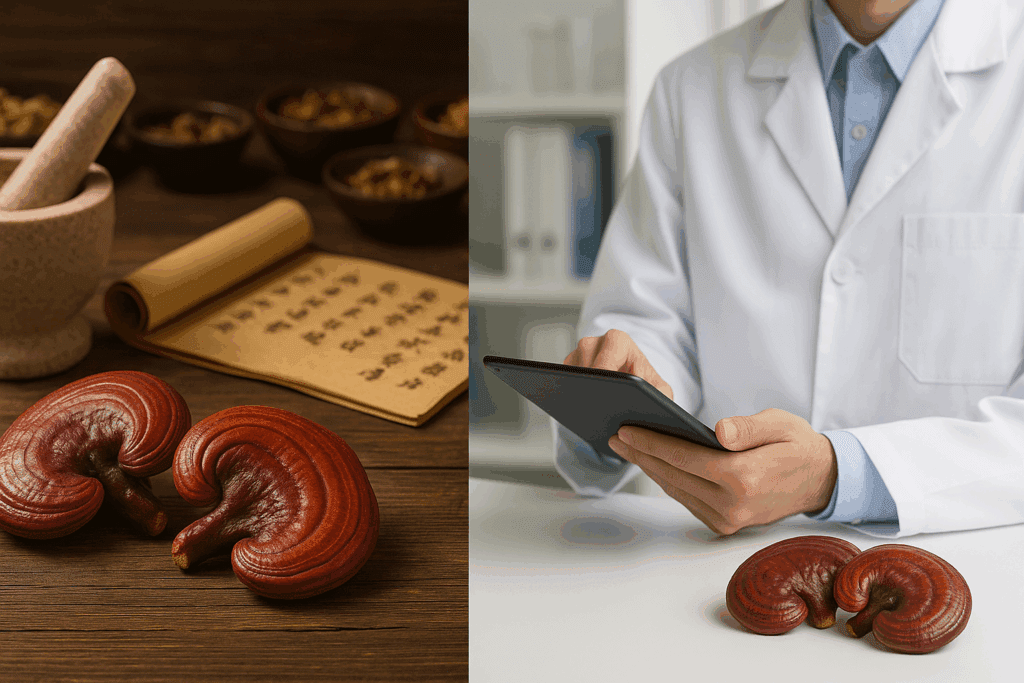
Red Reishi vs Reishi in Traditional and Modern Medicine
The history of reishi mushrooms is deeply intertwined with Eastern medical traditions, particularly Traditional Chinese Medicine (TCM). Within this system, red reishi is prized for its ability to nourish the “shen,” or spirit, making it a go-to remedy for emotional disturbances, insomnia, and mental fatigue. The TCM framework regards red reishi as superior to other varieties precisely because of its ability to calm the mind and stabilize emotional states.
In contrast, other reishi colors are often used for different energetic purposes. For example, black reishi may be employed to support kidney function and detoxification, while purple reishi is sometimes used for cardiovascular or liver-related imbalances. These distinctions further underscore the importance of selecting the right reishi type based on individual health goals.
Modern integrative medicine is increasingly embracing these ancient insights, blending them with contemporary research to develop more precise therapeutic protocols. Red reishi is now frequently recommended by naturopaths, integrative physicians, and mental health professionals as a natural adjunct to conventional treatments for anxiety and stress-related disorders. Its compatibility with other adaptogens, such as ashwagandha and rhodiola, allows for synergistic formulas that amplify its effects.
Practical Considerations When Choosing a Reishi Supplement
For consumers navigating the supplement market, clarity is critical. The ambiguity surrounding the term “reishi” can lead to suboptimal choices and diminished health outcomes. To ensure the best results, individuals should look for supplements that specify “red reishi” or Ganoderma lucidum on the label, accompanied by information about extraction method, triterpenoid concentration, and polysaccharide content.
Organic cultivation is another important factor. Reishi mushrooms are highly absorbent and can accumulate heavy metals and toxins from their environment. Reputable brands source their red reishi from organic farms and conduct third-party testing to verify purity. This is particularly important for those using reishi long-term for chronic stress and anxiety support.
Lastly, individuals should consider their preferred method of consumption. Capsules offer convenience and precise dosing, while tinctures may provide faster absorption. Teas and powders appeal to those who value traditional preparation methods, although the bitter taste can be off-putting for some. Whatever the format, the emphasis should be on consistency, quality, and alignment with one’s specific wellness goals.
Frequently Asked Questions: Red Reishi vs Reishi and Their Role in Stress Relief
How does the environment influence the therapeutic properties of red reishi vs reishi?
Environmental conditions such as temperature, humidity, altitude, and the type of substrate used for cultivation can significantly affect the chemical profile of reishi mushrooms. Red reishi cultivated in controlled environments tends to have higher concentrations of triterpenoids and polysaccharides due to standardized growing conditions. On the other hand, wild-harvested or mixed-variety reishi (when the product label simply reads “reishi”) may vary dramatically in bioactive compound levels. This variability can lead to unpredictable outcomes, particularly when used for stress and anxiety management. Consumers who prioritize consistency in results should be aware of how cultivation techniques influence the red reishi vs reishi debate and opt for lab-tested, quality-controlled products.
Are there any cognitive or neuroprotective differences when comparing red reishi vs reishi?
Recent emerging studies have begun exploring red reishi’s potential for neuroprotection, particularly in aging populations and individuals under chronic stress. Red reishi’s triterpenoids show promising effects in modulating brain inflammation and supporting hippocampal function, which plays a key role in memory and emotional regulation. In contrast, other forms of reishi have not been as thoroughly evaluated for these specific cognitive benefits, making their effectiveness more speculative. Furthermore, red reishi appears to support neuroplasticity through its adaptogenic effects on the hypothalamic-pituitary-adrenal (HPA) axis, offering a unique therapeutic edge. Thus, for individuals focused on preserving long-term cognitive health, red reishi may provide more targeted support than generalized reishi formulations.
What impact does reishi color have on product standardization and consumer trust?
Reishi color is more than an identifier—it serves as an informal indicator of the mushroom’s bioactive potential. Red reishi is widely recognized for its consistency in delivering measurable amounts of ganoderic acids, which enhances its credibility and clinical use. Consumers often report more predictable results when using red reishi, which has contributed to greater trust in brands that highlight the reishi color on their labels. Conversely, products labeled with ambiguous terms like “full-spectrum reishi” or “reishi complex” may contain a mix of mushroom types, diluting their intended effects. Transparent labeling of reishi color helps consumers make more informed decisions, especially when managing conditions such as chronic stress or anxiety.
Is there a notable difference in user experience between red reishi vs reishi in tea form?
Yes, the user experience can differ markedly when consuming these mushrooms in tea form. Red reishi, known for its potent bitterness due to high triterpenoid content, often results in a stronger sedative and calming sensation shortly after consumption. This makes it especially popular among those dealing with acute anxiety or sleep disturbances. Conversely, reishi teas that blend multiple colors may have a milder flavor and less pronounced immediate effects, which can be disappointing for those expecting quick relief. Additionally, red reishi tea may be combined with synergistic herbs like lemon balm or chamomile to enhance palatability and increase its adaptogenic profile. This versatility and potency underscore red reishi’s superiority in tea-based applications for emotional balance.
How does the choice of extraction method affect the benefits of red reishi vs reishi?
Extraction plays a critical role in unlocking the therapeutic potential of any mushroom supplement. Dual extraction methods, which use both hot water and alcohol, are optimal for capturing the full spectrum of red reishi’s active compounds—particularly triterpenes and polysaccharides. When dealing with generic reishi products, extraction protocols are often inconsistent or poorly disclosed, leading to weaker or unbalanced formulations. This can result in reduced efficacy, especially for those using reishi for stress regulation. Red reishi extracts are more likely to undergo rigorous quality control, making them a preferable option for individuals who value transparency and potency in their wellness regimen. Understanding extraction methods is essential for evaluating the real-world effectiveness of red reishi vs reishi.
Can reishi color influence compatibility with other herbal adaptogens?
Absolutely. The specific phytochemical makeup linked to reishi color determines how well the mushroom pairs with other adaptogens. Red reishi’s strong grounding effect and central nervous system support make it highly compatible with calming herbs such as ashwagandha, tulsi, and passionflower. Other reishi types, like black or purple reishi, may offer cardiovascular or detoxification support but might not blend as seamlessly in formulas targeting emotional resilience. The more precise the reishi color used, the more effectively practitioners can craft synergistic formulas to meet specific health needs. As such, understanding the implications of reishi color is key when designing holistic strategies for managing anxiety, fatigue, or emotional burnout.
What social and cultural factors shape consumer perception of red reishi vs reishi?
In various cultures, especially across East Asia, red reishi is deeply embedded in spiritual and medicinal traditions, often symbolizing balance, longevity, and protection against misfortune. This cultural reverence has helped solidify its status as the premium option among medicinal mushrooms. Western consumers, influenced by modern supplement marketing, may encounter less differentiation and assume all reishi types offer the same benefits. However, informed users are beginning to recognize the historical and clinical preference for red reishi, shaping a more nuanced understanding. The evolution of global wellness trends suggests that education around red reishi vs reishi is crucial for encouraging responsible, empowered decision-making rooted in tradition and science.
What future innovations might shape the debate around red reishi vs reishi?
Advances in biotechnology and mycological research are likely to refine the red reishi vs reishi conversation significantly. Innovations such as DNA barcoding, nanotechnology-based delivery systems, and CRISPR-assisted cultivation are already being explored to enhance potency and bioavailability. These developments could lead to hyper-customized mushroom supplements that specify the exact genetic strain and its dominant compounds. In this future landscape, reishi color may become even more central to formulation science, potentially leading to standardized global classifications. As research continues to link specific reishi types to targeted outcomes, such as cortisol modulation or neurogenesis, consumers can expect increasingly precise guidance backed by molecular data.
How does long-term use of red reishi compare with general reishi in terms of emotional resilience?
Long-term use of red reishi has shown promising benefits in fostering emotional resilience and psychological flexibility. Its adaptogenic mechanisms may help users better recover from emotional triggers and maintain balance during prolonged stress. In contrast, generalized reishi blends may lack the concentration and specificity needed to build cumulative psychological advantages. Anecdotal reports and preliminary studies suggest that users who consistently consume red reishi for several months experience greater self-regulation and fewer mood fluctuations. The longevity of these benefits reinforces red reishi’s role not just as a stress reliever, but as a tool for developing deeper emotional fortitude over time.
In what ways can reishi color influence product sourcing ethics and sustainability?
Sustainability in the mushroom supplement industry is an emerging concern, and reishi color plays a role in sourcing practices. Red reishi is often cultivated using controlled organic methods, minimizing environmental degradation and allowing for traceability. However, when products are ambiguously labeled as reishi without indicating color or origin, they may be sourced from unsustainable wild-harvested environments, which can contribute to deforestation and ecosystem disruption. Transparent disclosure of reishi color and cultivation practices allows ethically minded consumers to make informed decisions. As environmental consciousness grows, the reishi color indicated on packaging could serve as an informal marker for sustainability, ethics, and ecological stewardship in the supplement industry.
Conclusion: Why Red Reishi Reigns Supreme for Stress and Anxiety Relief
The comparison of red reishi vs reishi is not a matter of semantics but a significant distinction rooted in biochemistry, clinical efficacy, and therapeutic tradition. Red reishi, with its unparalleled concentration of calming triterpenes and its consistent track record in both ancient and modern healing systems, stands out as the most effective choice for those seeking natural relief from stress and anxiety.
Understanding the role of reishi color in therapeutic potency further empowers consumers to make informed decisions tailored to their needs. While all reishi mushrooms offer some level of adaptogenic support, not all are created equal. Red reishi’s unique ability to calm the nervous system, regulate the HPA axis, and support emotional resilience makes it the preferred choice for anyone facing the mental and physical toll of modern life.
As the demand for natural solutions to mental health challenges continues to grow, the importance of clarity, quality, and evidence-based practice becomes paramount. By choosing high-quality red reishi supplements and incorporating them into a holistic wellness routine, individuals can unlock the full potential of this ancient adaptogen to navigate stress with greater ease, balance, and vitality.
Further Reading:
Ling Chih (Lingzhi; Reishi Mushroom)
Reishi Mushroom: Understanding the Different Types and Their Health Benefits
